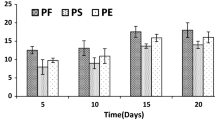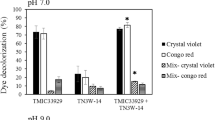Abstract
In order to explore ways for the application of white rot fungus in dye effluent treatment under non-sterile conditions, experiment on decolorization of reactive brilliant red was carried out, employing nitrogen-limited and carbon-limited medium with C/N ratio of 56/2.2 and 28/44 (in mmol/L), respectively. The results showed that the decolorization rate reached 92% while culturing white rot fungus with nitrogen-limited medium; however, the decolorization process ended in carbon-limited medium (n(C)/n(N) = 28/44) because of bacterial contamination. In addition, pH rose up to 9.31 after 4 d of decolorization, which was caused by bacterial contamination in the carbon-limited system. Therefore, it is concluded that nitrogen-limited medium can inhibit bacterial growth to some extent while carbon-limited medium is more easily contaminated by bacteria. Nitrogen-limited medium is more suitable in culture of white rot fungus for decolorization of reactive dye. Medium with the ability of inhibiting yeast growth should be developed by adjusting other components of nitrogen-limited medium.
Similar content being viewed by others
References
Tien M, Kirk T K. Lignin-degrading enzyme from the hymenomycete Phanerochaete chrysosporium, Science, 1983, 221: 661–663
Li H R. A review of the study on white rot fungus. Environmental Progress (in Chinese), 1996, 4(6): 69–77
Heinfling A, Bergbauer M, Szewzyk U. Biodegradation of azo and phthalocyanine dyes by Trametes versicolor and Bjerkandera adusta. Appl Microbiol Biotechnol, 1997, 48(2): 261–266
Borchert M, Libra J A. Decolorization of reactive dyes by the white rot fungus Trametes versicolor in sequencing batch reactors. Biotechnol Bioeng, 2001, 75(3): 313–321
Swamy J, Ramsay J A. The evaluation of white rot fungi in the decoloration of textile dyes. Enzyme Microbial Technology, 1999, 24(3–4): 130–137
Lorenzo M, Moldes D, Couto S R, Sanroman A. Improving laccase production by employing different lignocellulosic wastes in submerged cultures of Trametes versicolor. Bioresource Technol, 2002, 82(2): 109–113
Novotny C, Rawal B, Bhatt M, Patel M, Sasek V, Molitoris H P. Capacity of Irpex lacteus and Pleurotus ostreatus for decolorization of chemically different dyes. J Biotechnol, 2001, 89(2–3): 113–122
Spadaro J T, Gold M H, Renganathan V. Degradation of azo dyes by the lignin-degrading fungus Phanerochaete chrysosporium. Appl Environ Microbiol, 1992, 58: 2397–2401
Heinfling A, Martinez M J, Martinez A T, Bergbauer M, Szewzyk U. Transformation of industrial dyes by manganese peroxidases from Bjerkandera adusta and Pleurotus eryngii in a manganese-independent reacxtion. Appl Environ Microbiol, 1998, 64(8): 2788–2793
Leidig E, Prusse U, Vorlop K D, Winter J. Biotransformation of Poly R-478 by continuous cultures of PVAL-encapsulated Trametes versicolor under non-sterile conditions. Bioprocess Eng, 1999, 21(1): 5–12
Libra J A, Borchert M, Banit S. Competition strategies for the decolorization of a textile-reactive dye with the white-rot fungi Trametes versicolor under non-sterile conditions. Biotechnilogy and Bioengineering, 2003, 82(6): 736–744
Tien M, Kirk T K. Lignin peroxidase of Phanerochaete chrysosporium. Methods in Enzymology, 1988, 161: 238–249
Gao D W, Wen X H, Qian Y. Effect of nitrogen concentration in culture mediums on growth and enzyme production of Phanerochaete chrysosporium. J Environ Sci, 2005, 17(2): 190–193
Paszczynski A, Crawford R L, Huynh V B. Manganese peroxidase of Phanerochaete chrysosporium: purification. Methods in Enzymology, 1988, 161: 264–270
Zhang Y F, Li H Z, Hua Z Z, Chen J. Comparsion of the decolorizing characteristics of LiP and MnP. Environ Res (in Chinese). 2002, 15(5): 17–21
Mahnaz M A, Khosrow R, Majid S, Mehrdad A. Decolorization of textile wastewater by Phanerochaete chrysospovium. Desalination, 2001, 141: 331–336
Author information
Authors and Affiliations
Corresponding author
Additional information
Supported by the National Natural Science Foundation of China (Grant No. 50478010) and China Postdoctoral Research Foundation (Grant No. 20040350022)
Rights and permissions
About this article
Cite this article
Gao, D., Wen, X. & Qian, Y. Comparative study on using carbon or nitrogen limited medium to culture white rot fungi for reactive brilliant red dye K-2BP decolotization under non-sterile conditions. SCI CHINA SER B 50, 718–724 (2007). https://doi.org/10.1007/s11426-007-0108-7
Received:
Accepted:
Issue Date:
DOI: https://doi.org/10.1007/s11426-007-0108-7




